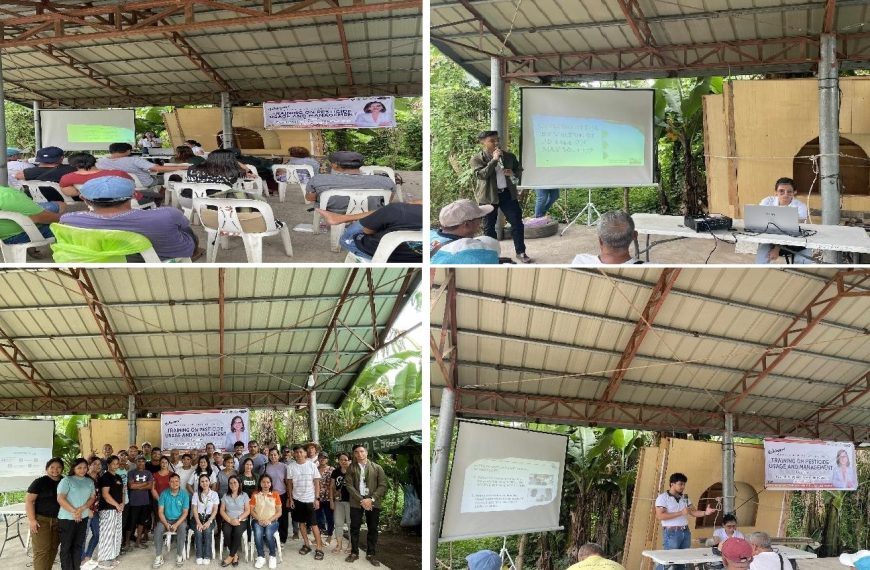Standing firm on its mandate to assure the agricultural sector of quality fertilizers, the Fertilizer and Pesticide Authority (FPA) reiterates industry compliance and renewed commitment relative to the implementation of existing national policies governing the agricultural sector.
Under Section 8.3 of the Fertilizer Regulatory Policies and Implementing Guidelines, a policy developed through the collaboration of FPA and the Fertilizer Industry Association of the Philippines (FIAP), a standard of 50 kg net weight of fertilizers was established to ensure end-users are buying the right quantity all the time. This position was reiterated through Memorandum No. 92-01.
Alongside complaints from farmers on the fertilizer price hike since 2021, the agency also received reports about ‘underweight’ fertilizer sacks that fall short from 100 grams [to even four kilograms] against the specified standard quantity. To verify such incidents, the FPA initiated the conduct of random fertilizer weight monitoring in the 14 Regions from January 30 to 7 June 2024.
The monitoring activity aims to explore the root causes of underweight packaging and its implications for distributors, dealers/retailers, and farmers and fishers. Moreover, it will address the key policy issue of “whether or not farmers and fishers are using the right amount of fertilizer” or “if the handlers adhere to the standard weight of fertilizers.”
The findings will provide insights and propose recommendations to abate the slated issue, including strengthening enforcement mechanisms, implementing quality control measures, and raising awareness about adherence to standard weights for a fair and sustainable fertilizer market.
Thirty-two (32) fertilizer grades were purposively random sampled from twenty-two (22) fertilizer importing companies, and four local blended/manufacturer companies involving 58 distributors and 65 dealers/retailers. The grades were selected based on their physical attributes including meeting the requirement of 50kg net capacity indicated in sacks.
Findings revealed that of the 17,602 sacks appraised, 49.17% (8,655 sacks) were found underweight from the 50kg net throughout the 14 regions involving 35 provinces, 54 municipalities, and 22 cities. The most recorded underweight is in CAR (77.62%) followed by Regions 12 (68.94%), 13 (68.54%), 4 (67.96%), 1 (64.95%), 9 (57.65%), 2 (49.17%), 11 (40.18%), 6 (39.38%), 10 (38.93%), 7 (30.29%) while the least was in Regions 3 (25.48%), 5 (23.91%) and 8 (23.10%).
The total % average of underweight is 49.17% as shown in Table 1. For each grade, above 50% underweight are the following: 0-22-0 (65%) followed by 21-0-0 (58.65%), 15-9-20 (57.93%), 15.5-0-0 (53.33%), 46-0-0 (52.07%), 14-14-14 (52.05%), 16-20-0 at 50.65%. Fertilizer grades from 30% to 40% underweight are 15.4-0-0 CaO=25.6, B=0.3 (46.84%), 19-1.1-6.5 (46.67%), 0-0-60 (45.68%), 16-16-16 (42.72%), 25-0-0 (42.69%), 18-46-0 (34.24%), 4-14-0 (33.33%), 2-0-0 (31-11%), and 4-2-2 (30%).
Likewise, underweight grades which range from 10%-20% are the following: 15.5-0-0, Ca=18.8 (8.57%), 18-6-0.2 (24%), 17-7-17 (20.88%), 17-0-17 (17.38%), 19-1.1-6.5 (16%), 0-0-50 (12%), and 10-10-10 (12%). At the same time, grades under 10% are 19-4-19 (8.20%), 12-12-17 (8%), and 45.8-0-0 (6.67%). Moreover, 6 fertilizer grades had no underweight sacks specifically 0-0-61, 0-24-0, 13-11-21, 15.5-0-0 CaO=26.5, 15-5-15, and 8-8-8+MgO.
Table 1. Summary of Fertilizer Grades
| No. | Fertilizer Grade | Total | |||
| Inventory (sacks) | Samples (sacks) | Underweight (sacks) | % Underweight | ||
| 1 | 0-22-0 | 5,486 | 100 | 65 | 65.00 |
| 2 | 21-0-0 | 294,353 | 3,035 | 1,780 | 58.65 |
| 3 | 15-9-20 | 11,715 | 271 | 157 | 57.93 |
| 4 | 15.5-0-0 | 433 | 75 | 40 | 53.33 |
| 5 | 46-0-0 | 528,664 | 4,056 | 2,112 | 52.07 |
| 6 | 14-14-14 | 348,506 | 3,414 | 1,777 | 52.05 |
| 7 | 16-20-0 | 189,573 | 2,628 | 1,331 | 50.65 |
| 8 | 15.4-0-0, CaO=25.6, B=0.3 | 13,916 | 190 | 89 | 46.84 |
| 9 | 19-1.1-6.5 | 64 | 15 | 7 | 46.67 |
| 10 | 0-0-60 | 350,578 | 1,561 | 713 | 45.68 |
| 11 | 16-16-16 | 2,542 | 206 | 88 | 42.72 |
| 12 | 25-0-0 | 17,131 | 260 | 111 | 42.69 |
| 13 | 18-46-0 | 42,454 | 479 | 164 | 34.24 |
| 14 | 4-14-0 | 3,422 | 45 | 15 | 33.33 |
| 15 | 2-0-0 | 1,708 | 45 | 14 | 31.11 |
| 16 | 4-2-2 | 10 | 10 | 3 | 30.00 |
| 17 | 15.5-0-0, Ca=18.8 | 54,177 | 154 | 44 | 28.57 |
| 18 | 18-6-0.2 | 2,269 | 50 | 12 | 24.00 |
| 19 | 17-7-17 | 532 | 91 | 19 | 20.88 |
| 20 | 17-0-17 | 18,143 | 443 | 77 | 17.38 |
| 21 | 19-1.1-6.5 | 1,102 | 50 | 8 | 16.00 |
| 22 | 0-0-50 | 1,800 | 50 | 6 | 12.00 |
| 23 | 10-10-10 | 5,003 | 50 | 6 | 12.00 |
| 24 | 19-4-19 | 31,042 | 122 | 10 | 8.20 |
| 25 | 12-12-17 | 1,751 | 75 | 6 | 8.00 |
| 26 | 45.8-0-0 | 1,055 | 15 | 1 | 6.67 |
| 27 | 0-0-61 | 25 | 5 | 0 | 0 |
| 28 | 0-24-0 | 50 | 25 | 0 | 0 |
| 29 | 13-11-21 | 1,195 | 5 | 0 | 0 |
| 30 | 15.5-0-0 CaO=26.5 | 1,812 | 35 | 0 | 0 |
| 31 | 15-5-15 | 344 | 37 | 0 | 0 |
| 32 | 8-8-8+3 MgO | 23 | 5 | 0 | 0 |
| Total | 1,930,878 | 17,602 | 8,655 | 49.17 | |
In protecting the rights and welfare of farmers and fishers, the FPA believes that the persistence of the status quo will compromise the attainment of food security in the country. Application of underweight fertilizers poses negative implications for the value of money, nutrient deficiency on fertilizer recommendation for achieving optimum yield, and loss of income by distributors, and dealers/retailers including the loss of government funds for farmers’ subsidy on fertilizers.
Towards the end, farmers and fishers, who play a crucial role as backbone of country’s food security, deserve proper treatment by providing what is due to them — right quantity of fertilizer bags. The FPA thus urges all industry players involved in the distribution line – from importers, distributors to dealers, to adhere to regulatory standards.
Moving Forward
In a decisive action to promote sustained efforts among concerned authorities and the industry, the following must be realized:
Policy Direction
- FPA, as the mandated authority, must ensure that the consumer or the farmer is supplied with fertilizers of standard quantity through issuance of laws and policies regulating the manufacture and sale of various fertilizers.
- The Fertilizer Control Act (FCA) should be in place and keep a strict watch in the quantity control of fertilizers, therefore players involved in the fertilizer business either as importers, manufacturers, distributors, dealers/retailers, or salespersons, shall have the proper knowledge to avoid infringement of government regulations.
- Institutionalize a `Border Control´ system where port entry of fertilizers is operated by importers.
- The government through the House of Representatives must pass legislation to sanction and penalize companies whose practices does not conform to regulatory standards.
Other direct effects of underweight fertilizers
- The bagging and re-bagging system by importers and local blenders should be improved through the use of state-of-the-art equipment by shifting from a mechanical weighing scale method (i.e. Lose weight type scale) to a digital weighting method (i.e. 50kg sack automatic weighing bagging filling scale). Digital scales are more accurate and precise than mechanical scales.
- The weight of fertilizer with sack should be 50.2kg to meet the required 50kg net content and to augment spillage.
- Improvement in the stitching of 50kg net sacks through double folding before sewing to avoid spillage during logistics.
- For dealers/retailers, before re-bagging into smaller packs (i.e. 1kg – 5 kg), get hold of the 50.2kg gross weight to ensure a 50kg net to avoid income shortfall.
###
Written by: Myer G. Mula, Kathleen Faye B. Agonoy, and Edward Allen A. Calapatia
|
Fertilizer and Pesticide Authority (FPA) Online ISSN: 2815-1674
Published by the FPA Information and Communications Team





